Egal, ob Praktikum, Ausbildung oder Festanstellung – der erste Schritt auf dem Weg zum Traumjob ist immer eine erfolgreiche Bewerbung. Sie haben viele interessante Stellenangebote gefunden, doch das Schreiben der Bewerbungen bereitet Ihnen Kopfzerbrechen? Keine Sorge, damit sind Sie nicht allein. Für viele ist das Bewerbungsschreiben ein großes Hindernis, denn es erfordert eine ehrliche Selbsteinschätzung und ist mit einer aufwändigen Formulierung der eigenen Fähigkeiten verbunden.
Doch der Arbeitsaufwand lohnt sich, denn nur ein gelungenes Bewerbungsschreiben öffnet Ihnen die Türen zu einem persönlichen Vorstellungsgespräch und bringt Sie einen Schritt näher zu Ihrem Traumjob. Im Folgenden erfahren Sie, worauf Sie beim Schreiben Ihrer Bewerbung achten sollten.
Warum ein Bewerbungsschreiben wichtig ist
Das Bewerbungsschreiben ist ein fester Bestandteil jeder Bewerbung. Während Sie im Lebenslauf Ihre Hard Skills unterbringen, widmen Sie Ihr Anschreiben Ihren Soft Skills. Diese haben in den letzten Jahren immer mehr an Bedeutung gewonnen, weswegen auch das persönliche Bewerbungsschreiben im Auswahlverfahren mehr in den Fokus gerückt ist.
Mit einem Anschreiben haben Sie die Möglichkeit, sich selbstbewusst zu präsentieren und Ihre positiven Eigenschaften hervorzuheben. Dabei geht es einerseits um Selbstdarstellung durch das Auflisten von relevanten Qualifikationen, andererseits um das sprachliche Hervortun aus der Masse an Bewerbern.
Die Vorbereitung für Ihr Anschreiben
Bevor Sie mit dem Schreiben starten, sollten Sie ein Informationsblatt anlegen. Schließlich benötigen Sie Informationen über das Unternehmen, die Anforderungen und natürlich einen Überblick über Ihre eigenen Qualifikationen, um Ihr Bewerbungsschreiben an die Stellenanzeige anpassen zu können.
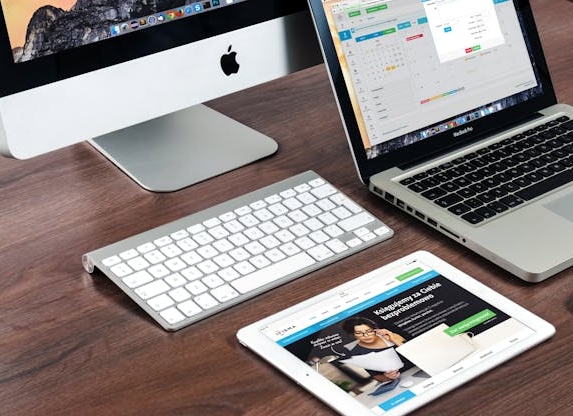
Bedienen Sie sich bei Ihrer Recherche an verschiedenen Quellen.
Dabei hilft Ihnen ein strukturiertes Vorgehen, relevante Informationen herauszuarbeiten und später nicht zu ausschweifend zu schreiben. Das Anschreiben basiert auf Ihren Bewerbungsunterlagen. Diese sollten Sie vorher zusammenstellen und gegebenenfalls an die Stellenausschreibung anpassen.
Relevante Qualifikationen finden in sechs Schritten
- Lesen Sie sich die Stellenausschreibung aufmerksam durch und schreiben Sie auf, welche Anforderungen an Sie gestellt werden.
- Gleichen Sie das Anforderungsprofil mit Ihren Zeugnissen, Kenntnissen und Erfahrungen ab. Suchen Sie nach Übereinstimmungen, welche Sie für die Stelle qualifizieren, und ergänzen Sie wichtige Qualifikationen in Ihrem Lebenslauf, wenn Sie diese noch nicht genannt haben.
- Stellen Sie sich auf Grundlage Ihrer Hard Skills und dem Anforderungsprofil folgende Fragen zu Ihren persönlichen Fähigkeiten und beantworten Sie diese ehrlich:
- Wo liegen meine Stärken und was kann ich verbessern?
- Welche Aufgaben erledige ich mit Begeisterung?
- Was wünsche ich mir von der neuen Stelle? In welchem Bereich möchte ich noch etwas lernen?
- Schreiben Sie in die linke Tabellenspalte all Ihre Hard Skills. Dazu gehören neben beruflichen Erfahrungen vor allem Abschlüsse, Praktika, Fremdsprachen- und Computerkenntnisse, aber auch ehrenamtliches Engagement.
- In die rechte Spalte kommen Soft Skills, welche Sie während Ihrer Tätigkeiten erworben oder ausgebaut haben. Dazu zählen zum Beispiel Teamgeist, Begeisterungsfähigkeit oder Durchsetzungsvermögen.
- Markieren Sie nun, welche Kompetenzen in der Stellenausschreibung erwähnt wurden und dementsprechend in Ihrem Bewerbungsschreiben einen Platz erhalten sollten.
Aus diesen Fragen soll hervorgehen, was Ihre Persönlichkeit ausmacht und was Sie von Anderen unterscheidet. Um die oben erlangten Erkenntnisse auf Ihre Relevanz zu überprüfen, hilft es, diese tabellarisch darzustellen.
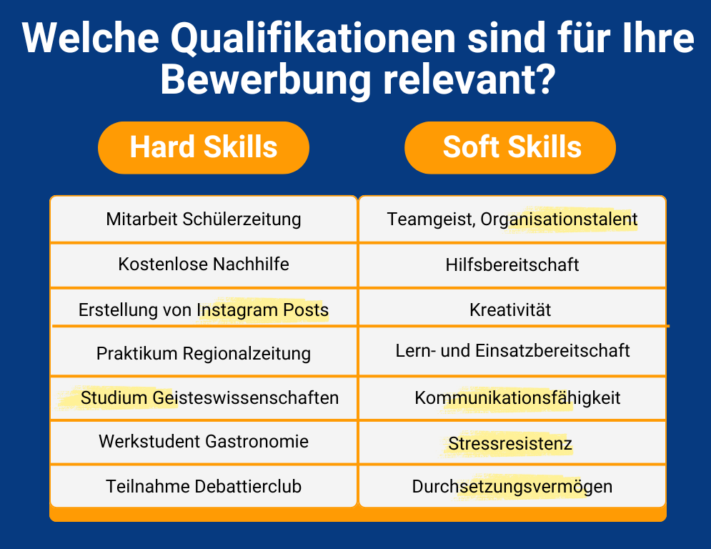
Verbinden Sie die erlernten Soft Skills mit den dazugehörigen Hard Skills.
Alle Qualifikationen, welche Sie nicht als bewerbungsrelevant markiert haben, können Sie zur Seite legen. Seien Sie dabei konsequent und streichen Sie auch Informationen, welche zwar etwas Positives über Sie aussagen, aber nicht zur Stelle passen.
Bewerbungsübersicht anlegen
Damit Sie auf der Jobsuche nicht den Überblick darüber verlieren, wo Sie sich wann und mit welchen Unterlagen beworben haben, sollten Sie eine Tabelle anlegen. Um die von Ihnen ausgearbeiteten Informationen und Dokumente immer griffbereit zu haben, bietet SeaTable Ihnen eine strukturierte Bewerbungsübersicht. Sehen Sie auf einen Blick alle Ihre Bewerbungen und die dazugehörigen Unterlagen und erleichtern Sie sich das Erstellen von Anschreiben mit dem Seitendesign.
Wenn Sie SeaTable für Ihren Bewerbungsplaner nutzen möchten, registrieren Sie sich einfach kostenlos. Die Vorlage finden Sie hier.
Formalien in Ihrem Bewerbungsschreiben
Bevor Sie mit dem Formulieren Ihrer Bewerbung beginnen, gilt es, ein einheitliches Design für alle Ihre Bewerbungsunterlagen festzulegen. Damit sieht Ihre Bewerbung nicht nur auf den ersten Blick stimmiger aus, sondern Sie vermitteln, dass Sie ordentlich und sauber arbeiten.
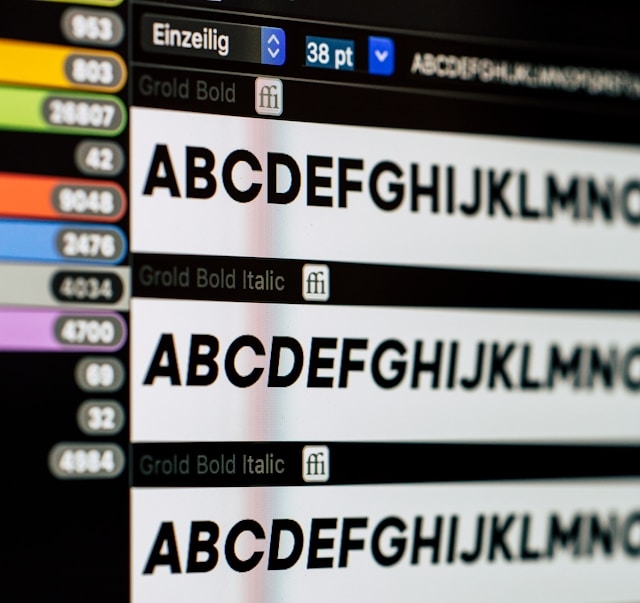
Suchen Sie eine passende Schriftart und achten Sie auf Schriftgröße, Zeilenabstand und Seitenrand.
Wie Sie Ihre Unterlagen gestalten, ist dabei voll und ganz Ihnen überlassen, denn es gibt kein vorgegebenes Format. Achten Sie jedoch darauf, dass Ihre Schrift gut leserlich ist und dass Sie das Bewerbungsschreiben übersichtlich strukturieren. Im Folgenden finden Sie einige Empfehlungen:
- Schriftart: gut lesbar, nicht zu ausgefallen, z. B. Times New Roman oder Arial, optimal in der Größe 10-12 Punkt
- Zeilenabstand: minimal einzeilig und maximal 1,5-zeilig
- Länge: maximal eine DIN A4 Seite
- Ränder: oben und unten jeweils 2cm Rand, links und rechts 2,5cm
- Bündigkeit: linksbündig, Ausnahme: Datum
Diese Formalien können Sie natürlich auch auf weitere Bewerbungsunterlagen anwenden, um ein einheitliches und stimmiges Bild zu schaffen.
Der Aufbau Ihres Anschreibens
Der Aufbau eines Bewerbungsschreibens sieht immer gleich aus und lässt sich in sechs Abschnitte unterteilen.
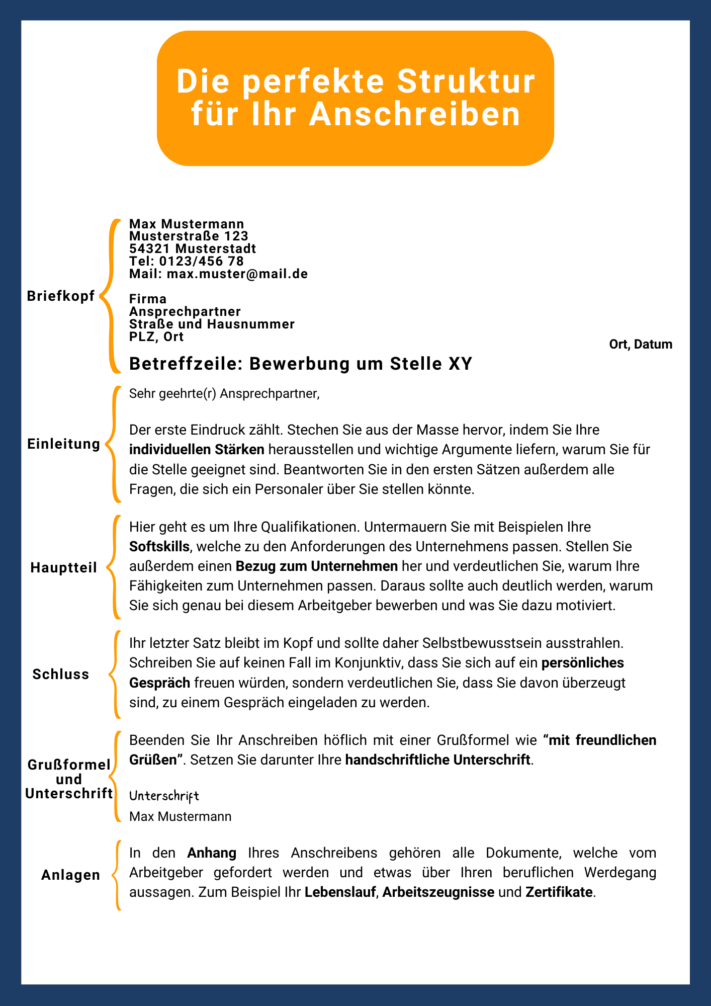
Folgen Sie der Struktur und füllen Sie diese mit Inhalt.
Briefkopf
Der Briefkopf wird klassischerweise verwendet, wenn Sie Ihr Bewerbungsschreiben per Post verschicken. Aber auch bei einer Online-Einreichung sollten Sie Ihrem Anschreiben einen Briefkopf hinzufügen. Dieser enthält Ihre Kontaktdaten sowie die Adresse des Unternehmens und den Empfänger, an den Sie Ihre Bewerbung schicken. Achten Sie darauf, dass Sie die Adressdaten, so wie in der Abbildung gezeigt, in der richtigen Reihenfolge angeben.
Die Adresse sollte in jedem Fall fehlerfrei und lückenlos sein. Überprüfen Sie, ob der Firmenname vollständig ist. Um unnötige Fehler zur vermeiden, übernehmen Sie die Schreibweise des Unternehmens von der Webseite. Der Name Ihres Ansprechpartners sollte stimmen und wenn angegeben mit akademischem Titel genannt werden.
Mit einigem Abstand folgt dann rechtsbündig die Angabe des Datums. Dieses ist in Deutschland wie folgt aufgebaut:
Ort, Tag.Monat.Jahr.
Den Monat können Sie dabei entweder als Zahl oder als Wort schreiben.
Darunter folgt mit zwei bis drei Leerzeilen Abstand die Betreffzeile. Diese können Sie zum Beispiel durch fette Buchstaben oder eine größere Schrift hervorheben. Dadurch kann das Unternehmen Ihr Anliegen sofort zuordnen, was eine schnelle Bearbeitung ermöglicht. Geben Sie hier an, auf welche Stelle Sie sich bewerben und fügen Sie gegebenenfalls die Referenznummer hinzu.
Einleitung
Bevor Sie die Möglichkeit haben, inhaltlich mit Ihren Qualifikationen zu glänzen, gilt es, die Aufmerksamkeit Ihres Ansprechpartners zu gewinnen. Sprechen Sie diesen persönlich mit Namen an und verwenden Sie nur im Notfall die unpersönliche Bezeichnung Damen und Herren, wenn Ihnen niemand namentlich bekannt ist. Wählen Sie bei konservativeren Unternehmen eine klassische Anrede wie Sehr geehrte Frau XY, um Ihr Anliegen höflich einzuleiten. Bei Start-ups können Sie auch eine informelle Anrede wie Hallo liebes Marketing-Team, liebe Frau XY ausprobieren.

Schreiben Sie höflich, um bei Ihrem Gegenüber einen guten ersten Eindruck zu erwecken.
Der erste Eindruck zählt. Daher sollten Sie sich mit dem ersten Satz in Ihrem Bewerbungsschreiben besonders intensiv beschäftigen. Denn dieser soll das Interesse wecken und entscheidet darüber, ob der Personaler Ihre Bewerbung weiterliest. Sätze wie Hiermit bewerbe ich mich auf die Stelle XY sollten Sie dabei auf jeden Fall vermeiden, da diese für den Personaler keine relevanten Informationen über Sie als Person liefern.
Es ist wichtig, dass der erste Satz nicht mit einer langweiligen Floskel in der Masse untergeht. Machen Sie deutlich, was Sie von den anderen Bewerbern unterscheidet. Nutzen Sie dafür prägnante Schlagwörter, welche Ihre Persönlichkeit und Fähigkeiten beschreiben und die Sie im Hauptteil aufgreifen können. Beginnen Sie zum Beispiel mit einem persönlichen Bezug zum Unternehmen, Ihrer einzigartig hohen Motivation oder einem spannenden Alleinstellungsmerkmal.
Hauptteil
Der Hauptteil ist der Kern Ihres Anschreibens. Hier sollten Sie alle relevanten Informationen in fünf bis sieben Zeilen unterbringen. Es gilt, Ihre Fähigkeiten und Motive kurz und prägnant darzustellen und dem Personaler zugleich einen umfassenden Eindruck Ihrer Persönlichkeit zu vermitteln.
Ihre Qualifikationen
Was macht Sie aus? Dieser Frage widmen Sie sich hier im Detail. Stellen Sie nachvollziehbar dar, dass Sie für alle Aufgaben in der Stellenausschreibung qualifiziert sind und sich auch neuen Herausforderungen mit Ihrem Können stellen. Dafür verbinden Sie die bereits im Lebenslauf aufgelisteten Fähigkeiten mit Ihren Soft Skills. Nennen Sie dazu konkrete Beispielsituationen, in denen Sie Skills im beruflichen oder privaten Kontext erworben oder angewendet haben.
Cultural Fit zum Unternehmen
Wichtig ist auch, ob Sie neben Ihren fachlichen Qualifikationen auf persönlicher Ebene zum Unternehmen passen. Zeigen Sie, dass Sie sich mit den Werten des Unternehmens identifizieren und sich in die Unternehmenskultur integrieren wollen. Das erreichen Sie, indem Sie darlegen, wie Sie die Firma bereichern werden und was Ihre Motivation ist, dort zu arbeiten.
Schluss
Das Beste kommt zum Schluss. Hier ist Platz für Ihre Angaben zu Gehaltsvorstellungen oder dem frühesten Eintrittsdatum.
Dem Schlusssatz kommt eine besondere Bedeutung zu, da dieser dem Personaler am längsten in Erinnerung bleibt. Daher ist es wichtig, dass Sie Selbstbewusstsein ausstrahlen und nochmals verdeutlichen, dass Sie mit einer positiven Rückmeldung rechnen. Um das zu bewirken, sollten Sie den Konjunktiv vermeiden. Ein Abschluss wie Ich würde mich über die Einladung zu einem Bewerbungsgespräch freuen wirkt so zurückhaltend, als seien Sie sich Ihrer eigenen Qualifikation für die Stelle unsicher.

Behalten Sie Ihr Ziel vor Augen: Mit Selbstbewusstsein zum Bewerbungsgespräch.
Finden Sie ein gutes Mittelmaß, um freundlich, höflich sowie selbstbewusst zugleich zu klingen. Dafür bietet sich eine klare Aussage wie Ich freue mich, Sie bei einem Vorstellungsgespräch persönlich kennenzulernen an.
Grußformel und Unterschrift
Genau wie bei der Anrede soll die Grußformel dem Unternehmen angemessen sein. “Mit freundlichen Grüßen” ist für Sie immer die sicherste Wahl.
Nun fehlt nur noch Ihre handschriftliche Unterschrift. Diese können Sie entweder auf das ausgedruckte Bewerbungsschreiben setzen oder im Falle einer Online-Bewerbung digital via Touchpad unterschreiben oder Ihre Unterschrift einscannen und in Ihr Dokument einfügen.
Anlagen
Die geforderten Anlagen listen Sie am Ende Ihres Anschreibens unter der Überschrift Anlagen oder Anhang auf. Dazu gehören meist der Lebenslauf, Arbeits- und Praktikumszeugnisse sowie Zertifikate. Diese fügen Sie Ihrer Bewerbung in einer gesonderten PDF-Datei bei.
Sonderformen des Bewerbungsschreibens
Das klassische Bewerbungsschreiben, wie es oben erklärt wurde, kann in bestimmten Fällen variieren. Je nachdem, welcher Fall auf Sie zutrifft, sollten Sie Ihre Bewerbungsunterlagen entsprechend anpassen.
Praktikum
Möchten Sie sich im Rahmen eines Schüler- oder Hochschulpraktikums bewerben, setzen die Personaler keine oder wenige berufliche Qualifikationen voraus. Dafür punkten Sie vor allem mit passenden Soft Skills und Interessen, welche Sie in bestimmten Fächern, Ferienjobs, Ihrer Freizeit oder im Rahmen von eigenen Projekten und Ehrenämtern ausüben.
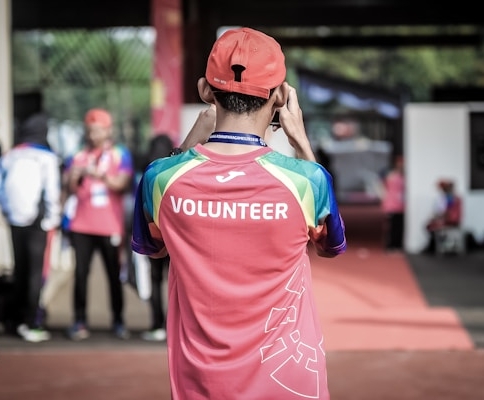
Zeigen Sie anhand eines Ehrenamtes Ihr soziales Engagement.
Außerdem interessiert sich Ihr Ansprechpartner für Ihre Motivation. Warum wollen Sie genau für dieses Unternehmen arbeiten? Was erhoffen Sie sich von dem Einblick in die Praxis? Zeigen Sie, was Sie begeistert.
Initiativbewerbung
Nicht immer finden Sie bei Ihrem Traum-Arbeitgeber eine passende Position unter den offenen Ausschreibungen. Das ist aber kein Grund aufzugeben, denn die meisten Firmen bieten die Möglichkeit zur Initiativbewerbung an. Dabei liegt Ihr Fokus auf einer ausgeweiteten Recherche, da Sie sich alle Informationen für Ihre Unterlagen selbst zusammensuchen müssen. Achten Sie darauf, Ihre Bewerbung nicht zu überfrachten, und reduzieren Sie Ihr Anschreiben auf die für Sie am wichtigsten erscheinenden Aspekte.
E-Mail-Bewerbung
Die meisten Bewerbungen werden heutzutage online verschickt. Wenn Sie Ihre Unterlagen als E-Mail absenden, gehört das Bewerbungsschreiben als PDF-Dokument in den Anhang. Der Betreff, also auf welche Stelle Sie sich bewerben, kommt in die dafür vorgesehene Betreffzeile. Schreiben Sie einen kurzen Zweizeiler in das Textfeld, in dem Sie Ihren Ansprechpartner benennen und auf die Unterlagen im Anhang hinweisen. Beenden Sie den Text mit einer Grußformel und Ihrem Namen.
Tipps und Tricks für Ihr Bewerbungsschreiben
Inhaltlich steht Ihre Bewerbung und Sie wollen ihr den letzten Schliff verpassen? Dann finden Sie hier einige hilfreiche Tipps und Beispiele, um Ihre Bewerbung zu perfektionieren.
Dos und Don’ts
Achten Sie auf Ihren Schreibstil und die von Ihnen verwendeten Formulierungen.
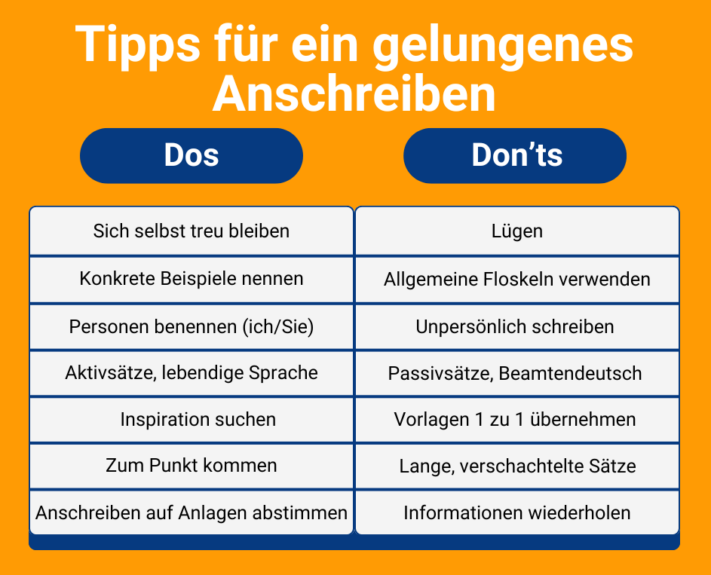
Achten Sie auf angemessene Formulierungen.
Um Selbstbewusstsein auszudrücken, verwenden Sie Aktivsätze und sprechen Personen direkt an. Achten Sie darauf, Ihr Anschreiben individuell zu gestalten und sich selbst treu zu bleiben.
Beispielformulierungen für Ihr Bewerbungsschreiben
Hier finden Sie Formulierungshilfen für verschiedene Situationen im Anschreiben:
Unternehmens- und Themenbezug herstellen
“Bei mehreren Praktika in der Medienbranche habe ich bereits Einblicke in die journalistische Arbeit erhalten. Nun möchte ich meine dort erarbeiteten Kompetenzen in die PR Ihres internationalen Unternehmens einbringen und weiterentwickeln.”
Berufserfahrung gewinnbringend verpacken
“Durch meine 10-jährige Tätigkeit im Verkauf weiß ich, wie man Kunden im direkten Kontakt begeistert, weshalb ich den Umsatz in Ihrem Sales Team erfolgreich steigern kann.”
Fachliche Qualifikationen herausarbeiten
“Dank meines Romanistikstudiums beherrsche ich Spanisch und Französisch auf dem Level B2 und habe diese Kenntnisse bei Auslandspraktika in Madrid und Paris praktisch angewandt und vertieft.”
Soft Skills begründen
“In meiner Position als stellvertretender Teamleiter habe ich einen kollegialen Führungsstil entwickelt, mit dem ich meinen Mitarbeitenden auf Augenhöhe begegne und ihnen Aufgaben anhand ihrer individuellen Fähigkeiten zuteile. Gemeinsam haben wir das Projekt in der Hälfte der vorgegebenen Zeit durchgeführt.”
Checkliste
Bevor Sie Ihre Bewerbung abschicken, sollten Sie diese final Korrektur lesen. Neben einer Rechtschreibprüfung hilft Ihnen folgende Checkliste, die Vollständigkeit Ihres Anschreibens zu gewährleisten:
- Stimmen alle Namen und sind sie richtig geschrieben?
- Haben Sie Ihr Bewerbungsschreiben klar und nicht zu floskelhaft formuliert?
- Bekommt der Personaler ein umfangreiches Bild von Ihren Qualifikationen?
- Haben Sie Ihre einzigartige Persönlichkeit genügend herausgearbeitet?
- Kann der Personaler beurteilen, welchen Mehrwert Sie dem Unternehmen bringen und ob Sie sich mit der Kultur identifizieren?
Fazit
Dem Schreiben Ihrer nächsten erfolgreichen Bewerbung steht nun nichts mehr im Wege. Damit Sie auch bei mehreren Bewerbungen nicht den Überblick über Ihre Unterlagen verlieren, hat SeaTable einen Online-Bewerbungsplaner für Sie erstellt. Dieser hilft Ihnen Ihre nächsten Schritte zu planen, Dokumente zu ordnen und immer auf dem neuesten Stand im Bewerbungsprozess zu bleiben.
Wenn Sie SeaTable für Ihre Bewerbungsübersicht nutzen möchten, registrieren Sie sich einfach kostenlos. Die Vorlage finden Sie hier.

